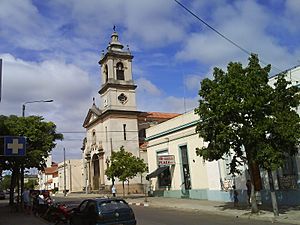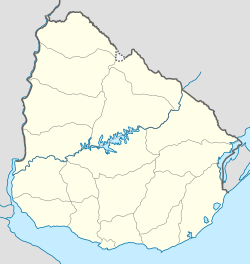Artigas, Uruguay facts for kids
Quick facts for kids
Artigas
|
||
|---|---|---|
|
Capital city
|
||

Church of the Sacred Heart
|
||
|
||
| Country | ||
| Department | ||
| Founded | September 12, 1852 | |
| Founded by | Don Carlos Catalá | |
| Elevation | 121 m (397 ft) | |
| Population
(2011 Census)
|
||
| • Total | 40,658 | |
| Demonym(s) | artiguense | |
| Time zone | UTC−3 (UYT) | |
| postal code |
55000
|
|
| Dial plan | +598 477 (+5 digits) | |
| Climate | Cfa | |
Artigas (Spanish pronunciation: [aɾˈtiɣas]) is an important city in Uruguay. It is the capital of the Artigas Department. The city is named after José Gervasio Artigas. He was a national hero who fought for freedom in the region. In 2011, Artigas was the eleventh largest city in Uruguay by population.
Contents
The Story of Artigas
Artigas was founded on September 12, 1852. Don Carlos Catalá started it as a town. Its first name was San Eugenio del Cuareim.
On September 5, 1884, it became the capital of the Artigas Department. The town was renamed Artigas on August 31, 1915. At that time, it also officially became a city.
What Artigas is Known For
Artigas is a key place for trading crops like maize. It trades with nearby countries, Argentina and Brazil. The city's train station and airport help with this trade. The airport opened in 1973.
The hills around Artigas are full of beautiful stones. These include agate and amethyst. People first found these gems in 1860. Since then, mining for them has been an important activity. Many souvenirs and crafts are made from these gemstones in Artigas. They are sold all over the world.
A Special Geological Site
Artigas is famous for its amazing amethyst deposits. Some of the biggest amethyst-filled geodes ever found were here. Because of this, the International Union of Geological Sciences (IUGS) recognized it.
In October 2022, they named the 'Deposits of Amethyst of Los Catalanes Gemological District' a 'geological heritage site'. This means it is a very important place for geology worldwide.
How Many People Live in Artigas?
In 2011, the city of Artigas had 40,658 people living there. Here is how the population has grown over the years:
| Year | Population |
|---|---|
| 1852 | 335 |
| 1908 | 8,857 |
| 1963 | 23,429 |
| 1975 | 29,256 |
| 1985 | 35,117 |
| 1996 | 40,244 |
| 2004 | 41,687 |
| 2011 | 40,658 |
Source: Instituto Nacional de Estadística de Uruguay
Where is Artigas Located?
Artigas is right on the border with Brazil. A bridge connects it to the Brazilian town of Quaraí. This town is in the state of Rio Grande do Sul.
Artigas is the city farthest from Montevideo, Uruguay's capital. It is about 600 kilometers (370 miles) away.
Artigas's Climate
Artigas has a humid subtropical climate. This type of climate is called Cfa by the Köppen climate classification. Summers are warm to hot. Winters are cool, and sometimes there are frosts and fog.
Rainfall is spread out evenly throughout the year. The city gets about 1,535 millimeters (60.4 inches) of rain each year. The average yearly temperature is around 19.6°C (67.3°F).
| Climate data for Artigas, Uruguay (1991–2020, extremes 1944–2020) | |||||||||||||
|---|---|---|---|---|---|---|---|---|---|---|---|---|---|
| Month | Jan | Feb | Mar | Apr | May | Jun | Jul | Aug | Sep | Oct | Nov | Dec | Year |
| Record high °C (°F) | 40.9 (105.6) |
41.2 (106.2) |
40.8 (105.4) |
36.0 (96.8) |
33.0 (91.4) |
30.2 (86.4) |
30.5 (86.9) |
34.4 (93.9) |
37.0 (98.6) |
37.4 (99.3) |
40.8 (105.4) |
41.4 (106.5) |
41.4 (106.5) |
| Mean daily maximum °C (°F) | 32.2 (90.0) |
31.1 (88.0) |
29.4 (84.9) |
25.7 (78.3) |
21.5 (70.7) |
19.2 (66.6) |
18.7 (65.7) |
21.1 (70.0) |
22.4 (72.3) |
25.0 (77.0) |
28.0 (82.4) |
30.8 (87.4) |
25.4 (77.8) |
| Daily mean °C (°F) | 25.8 (78.4) |
25.0 (77.0) |
23.3 (73.9) |
19.9 (67.8) |
16.2 (61.2) |
14.0 (57.2) |
13.3 (55.9) |
15.2 (59.4) |
16.7 (62.1) |
19.4 (66.9) |
21.7 (71.1) |
24.3 (75.7) |
19.6 (67.2) |
| Mean daily minimum °C (°F) | 19.4 (66.9) |
18.9 (66.0) |
17.3 (63.1) |
14.2 (57.6) |
10.9 (51.6) |
8.9 (48.0) |
7.9 (46.2) |
9.3 (48.7) |
11.0 (51.8) |
13.8 (56.8) |
15.5 (59.9) |
17.9 (64.2) |
13.8 (56.7) |
| Record low °C (°F) | 8.2 (46.8) |
7.9 (46.2) |
5.0 (41.0) |
1.8 (35.2) |
−3.0 (26.6) |
−4.6 (23.7) |
−5.2 (22.6) |
−4.3 (24.3) |
−2.8 (27.0) |
1.2 (34.2) |
3.0 (37.4) |
6.0 (42.8) |
−5.2 (22.6) |
| Average precipitation mm (inches) | 142.8 (5.62) |
137.0 (5.39) |
118.4 (4.66) |
180.1 (7.09) |
136.2 (5.36) |
92.1 (3.63) |
80.2 (3.16) |
65.4 (2.57) |
119.5 (4.70) |
158.3 (6.23) |
150.2 (5.91) |
155.2 (6.11) |
1,535.4 (60.43) |
| Average precipitation days (≥ 1.0 mm) | 7 | 7 | 6 | 8 | 6 | 6 | 6 | 6 | 7 | 8 | 7 | 7 | 81 |
| Average relative humidity (%) | 61 | 68 | 70 | 72 | 77 | 79 | 75 | 70 | 69 | 69 | 65 | 61 | 70 |
| Mean monthly sunshine hours | 276.7 | 231.8 | 233.1 | 188.7 | 168.3 | 138.7 | 164.4 | 198.2 | 192.2 | 217.3 | 262.7 | 274.7 | 2,546.8 |
| Source 1: Instituto Uruguayo de Metereología | |||||||||||||
| Source 2: NOAA (precipitation and sun 1991–2020), Instituto Nacional de Investigación Agropecuaria (humidity 1980–2009) | |||||||||||||
Getting Around Artigas
The city uses Artigas International Airport for air travel.
International Connections
Brazil has a Vice-consulate office in Artigas. This office helps Brazilian citizens and promotes ties between the two countries.
Places to Worship
- San Eugenio del Cuareim, Artigas|St. Eugene of the Cuareim Parish Church (Roman Catholic)
Famous People from Artigas
- Adelia Silva (1925–2004), an educator and writer who worked to improve civil rights for Afro-Uruguayans.
- Darwin Núñez (born 1999), a professional footballer.
- Pablo Aurrecochea (born 1981), a professional footballer.
- Agustín Da Silveira (born 2000), a professional footballer.
See Also
 In Spanish: Artigas (ciudad) para niños
In Spanish: Artigas (ciudad) para niños



